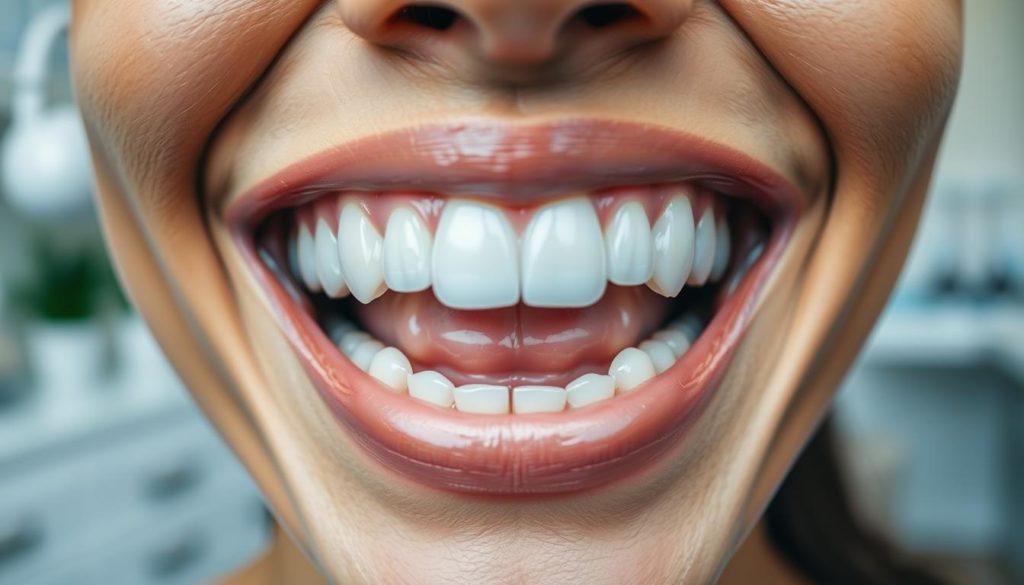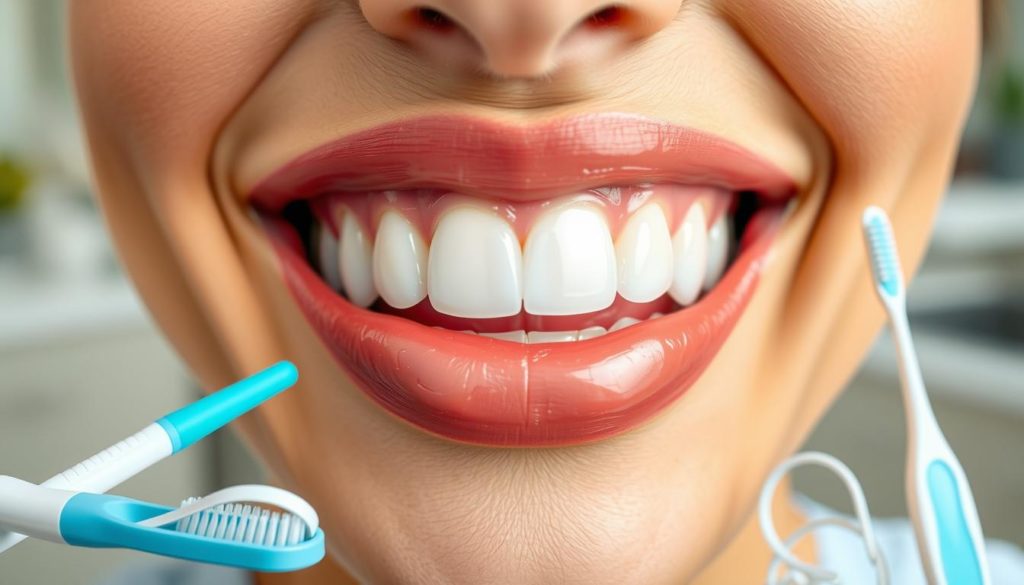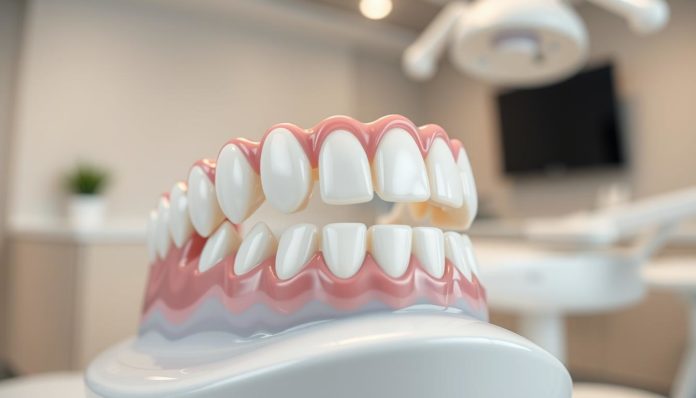Did you know that over 120 million Americans are missing at least one tooth? This fact shows a big concern. Missing teeth affect your smile’s look and its function. Dental bridges are a solid fix, acting as a dependable dental prosthetic. They fulfill your need to replace teeth and help you smile with confidence again.
Dental bridges are not just about covering gaps; they bring back the benefits of real teeth. They improve how you chew and speak. They also keep the natural shape of your face. Dive into the world of dental bridges. See how they can change your life and make you smile with confidence once more.
Understanding Dental Bridges
Dental bridges are a popular way to deal with missing teeth. They fill in the gap that missing teeth leave behind. These devices consist of two or more crowns on the sides of the gap. Between these crowns, there’s an artificial tooth or teeth.
The side teeth are called abutment teeth, and the fake ones are known as pontics. Pontics can be made from gold, alloys, porcelain, or a mix of these.
Dental bridges are an effective way to fix spaces where teeth are missing. They improve how your smile looks and help your teeth work right. This means you can chew and speak better. They also keep your other teeth from moving out of place.

- Abutment Teeth: Your existing teeth or dental implants that support the bridge.
- Pontics: Artificial teeth that replace the missing ones and are anchored by the abutments.
Dental bridges are made just for you. They match the color, shape, and size of your natural teeth. This means they look good and fit well with your smile.
Benefits of Dental Bridges for Oral Health
Dental bridges offer many positives for oral health. They boost both function and looks. This helps people keep a good quality of life. Let’s see how dental bridges can make oral health better.

Improving Chewing and Speaking
A big plus of dental bridges is they help you chew and speak better. Missing teeth can leave gaps, affecting how you talk and eat. Dental bridges fill these gaps. They let you enjoy many foods again and speak clearly.
Maintaining Facial Shape
Dental bridges also help keep your face’s shape. Losing teeth can make your face sag and look sunken. With dental bridges, your face muscles get support. This keeps your face’s natural shape and stops early aging signs.
Preventing Teeth Misalignment
Another benefit of dental bridges is stopping teeth from getting out of line. Without teeth, other teeth might move into those spaces. This can cause problems with how your teeth fit together. Dental bridges keep your teeth where they should be. They help keep your bite right.
The Bridge Procedure: Step-by-Step Guide
The bridge procedure involves several steps for long-lasting and good-looking results. We’ll guide you through each part, so you know what to expect.
- Initial Consultation: Your adventure starts with a detailed consultation. Your dentist checks your dental needs, takes X-rays, and talks about the best choices for you.
- Preparation of Abutment Teeth: Next, the teeth by the gap (abutment teeth) are reshaped for the dental bridge. A mold of these teeth is made for a perfect model.
- Temporary Bridge Fitting: A temporary bridge is placed to safeguard the exposed teeth and gums. This is while your permanent bridge is being made.
- Permanent Bridge Placement: When your permanent bridge is ready, the dentist takes off the temporary one. They then put in the permanent bridge, adjusting it to fit right and making sure your bite is correct.
After the bridge procedure, caring for your teeth is key to keeping your bridge in top shape. Brushing, flossing regularly, and going for dental check-ups are important for its upkeep and your oral health.
| Procedure Step | Description |
|---|---|
| Initial Consultation | Evaluate needs, take X-rays, discuss options. |
| Preparation of Abutment Teeth | Reshape adjacent teeth and take mold impressions. |
| Temporary Bridge Fitting | Install a temporary bridge to protect teeth and gums. |
| Permanent Bridge Placement | Fit and adjust the permanent bridge for comfort. |
Types of Dental Bridges
When you need to choose a dental bridge, it’s important to know the types available. Each one has its own features, benefits, and best uses. This knowledge helps you restore your smile.
Traditional Dental Bridges
Traditional dental bridges are very common. They have a crown on each side of the missing tooth area, with a false tooth in the middle. These bridges are strong and good for areas with natural teeth on both sides.
Cantilever Dental Bridges
Cantilever bridges are a bit like traditional ones but need only one adjacent tooth. They’re not as common. This type works well for the front teeth where there isn’t as much chewing pressure.
Maryland Bonded Bridges
Maryland bonded bridges are great for replacing front teeth. They use porcelain or metal attached to the back of adjacent teeth. This option needs little change to the nearby teeth.
Implant-Supported Bridges
Implant-supported bridges use implants instead of crowns or frames. They offer great stability, making them ideal for replacing several teeth. These bridges are durable and feel like your own teeth.
| Type of Bridge | Characteristics | Best for | Drawbacks |
|---|---|---|---|
| Traditional Dental Bridges | Uses crowns on both sides | Gaps with adjacent teeth | Requires alteration of healthy teeth |
| Cantilever Dental Bridges | Anchored on one side | Less stress areas | Less durable for stressed areas |
| Maryland Bonded Bridges | Bonded with wings | Missing front teeth | Less sturdy than other options |
| Implant-Supported Bridges | Uses dental implants | Multiple missing teeth | Requires surgical procedure |
Comparing Bridge vs Implant
Choosing between a dental implant bridge and traditional bridges involves many factors. These factors help make a choice that fits your needs and wants.
Longevity: The lifespan is a key point in this decision. Dental implants can last a lifetime with the right care. Yet, bridges might need replacing within 10-15 years.
Functionality: Both options help with eating and chewing. But, a dental implant bridge can better mimic a natural tooth root. This could lead to improved oral health over time.
Cost: Cost is crucial in deciding between a bridge and an implant. Dental implants usually cost more at first, but their long-lasting nature can offer better value. In contrast, dental bridges are more budget-friendly at the start.
Procedure:
- Implants involve placing the implant surgically into the jaw. Then, you wait for it to heal before adding the crown.
- For bridges, the teeth next to the gap are reshaped to hold the bridge. Then, the bridge is placed.
| Feature | Dental Implant Bridge | Traditional Bridge |
|---|---|---|
| Longevity | Lifetime (with care) | 10-15 years |
| Functionality | High (mimics natural roots) | Moderate |
| Cost | Higher initial cost | Lower initial cost |
| Procedure | Surgical and requires healing | Less invasive |
Cost Considerations of Dental Bridges
When you’re thinking about getting a dental bridge, know what affects the price. The type of bridge, what it’s made of, and how complex the work is play a big part.
Factors Influencing the Cost
Several things decide how much you’ll pay for a dental bridge:
- Type of Bridge: Choices like traditional, implant-supported, or cantilever bridges have different prices.
- Materials Used: Using porcelain, zirconia, or metal alloy can change the cost.
- Dental Office Location: Where the dentist’s office is and their level of skill can make a difference in price.
- Preparation Needed: If you need extra work like tooth removal or root canals, it will increase the total price.
Insurance Coverage for Dental Bridges
It’s important to know how dental bridge insurance can help you budget. Most insurance plans cover part of the cost for dental bridges. Always check your plan for coverage details, co-pay amounts, and yearly limits.
Let’s look at how insurance impacts your cost and compare it with what you might pay out of pocket:
| Type of Dental Bridge | Average Out-Of-Pocket Cost | Insurance Coverage |
|---|---|---|
| Traditional Bridge | $2,000 – $5,000 | 50% – 80% |
| Implant-Supported Bridge | $5,000 – $12,000 | 40% – 60% |
| Maryland Bonded Bridge | $1,500 – $2,500 | 50% – 70% |
How to Care for Your Dental Bridges
Taking good care of your dental bridge is crucial for its long life and your oral hygiene. We’ve put together important advice for your daily routine. These steps will keep your dental bridges in great shape.
Cleaning daily is key. Dental bridges should be cleaned twice a day, just like real teeth. Use a soft toothbrush and fluoride toothpaste for gentle cleaning. Also, flossing is important to remove plaque and bacteria under the bridge.
Adding oral hygiene products is vital too. Use an antiseptic mouthwash to kill bacteria missed by brushing and flossing. Interdental brushes can clean spots that regular brushes can’t reach.
Remember to see your dentist regularly. They check your dental bridges and clean professionally to keep your mouth healthy. Early problem detection and consistent dental visits help maintain your dental bridges.
Here is a simple guide for your dental bridge care routine:
| Action | Frequency | Tools Needed |
|---|---|---|
| Brushing | Twice daily | Soft-bristle toothbrush, fluoride toothpaste |
| Flossing | Once daily | Floss threader, dental floss |
| Using mouthwash | Daily | Antiseptic mouthwash |
| Dentist checkups | Biannually | N/A |
| Interdental brushing | As needed | Interdental brushes |
Following these dental bridge care steps helps their longevity and keeps your mouth healthy. Your effort in caring for them greatly affects their life and effectiveness.
Who is a Good Candidate for Dental Bridges?
Figuring out if someone is right for dental bridges is key to better dental function and looks. Many factors are weighed to make sure it’s a good fit for each person.
Health Conditions to Consider
Certain health conditions can impact whether someone is a good fit for dental bridges. Ideal candidates have healthy gums, enough bone, and great oral hygiene. But, issues like bad gum disease, a lot of bone loss, or serious tooth decay may need extra care first.
Consultation with Your Dentist
It’s important to get a tailored check-up. At this visit, your dentist will closely look at your oral health. They’ll talk about your dental past, do a check-up, and maybe take X-rays. This helps them come up with the best plan for you.
Taking these steps and getting advice from experts helps you decide if dental bridges are right for you.
Restoring Confidence with Dental Bridges
Dental bridges help give back a confident smile, greatly improving life quality. They fill the spaces left by lost teeth, helping people eat better and feel better about how they look. Many say their self-esteem gets a big boost after getting dental bridges. This leads to more socializing, improved work interactions, and a stronger feeling of happiness.
Many happy patients share their stories about dental bridges. Experts like Dr. Samantha Dunlop of the American Dental Association note a big rise in confidence after people get these. With gaps filled by realistic-looking teeth, individuals smile and talk more freely. This change boost confidence which positively changes their lives.
The high success rate of dental bridges shows they work well and are trustworthy. Thanks to new advancements, these treatments are quicker and less painful than before, with results looking very natural. Pictures from dentists show significant improvements in looks and smile quality. Getting a confident smile is not just a hope but a reality with dental bridges.
FAQ
What are dental bridges?
Dental bridges are used to replace missing teeth. They are anchored by crowns on natural teeth or dental implants. This helps in filling the space left by the lost tooth.
How do dental bridges work?
Bridges close the gap created by missing teeth. They are secured to teeth or implants on each side of this gap. This restores your smile and the function of your teeth.
What are the benefits of dental bridges?
Bridges improve your ability to chew and speak. They keep your face’s natural shape and stop other teeth from moving out of place.
What does the dental bridge procedure involve?
Getting a dental bridge involves a few steps. First is consultation, then preparing the abutment teeth or implants. Next, a temporary bridge is placed, followed by the permanent bridge. Aftercare is crucial.
What types of dental bridges are available?
There are four main bridge types: Traditional, Cantilever, Maryland Bonded, and Implant-Supported. Each one serves different needs.
How do dental bridges compare to dental implants?
Bridges and implants are two ways to replace teeth. Bridges are faster and less invasive. But implants may last longer and function better. The condition of your teeth and cost matter too.
What factors influence the cost of dental bridges?
The cost depends on how many teeth need replacement, the bridge type, materials, and if extra treatments like implants are needed.
Is dental bridge coverage included in insurance?
Many insurance plans help pay for bridges. But it’s important to check your policy for details as coverage varies.
How should I care for my dental bridges?
Care for bridges by brushing, flossing, using mouthwash, and seeing your dentist regularly. Sometimes, special tools are recommended for cleaning.
Who is a good candidate for dental bridges?
Ideal candidates have one or more missing teeth, good oral health, and firm teeth or jawbone for support. It’s best to see a dentist to know if a bridge is right for you.
How can dental bridges restore confidence?
Bridges can greatly enhance your smile and confidence. They often lead to a better life and self-esteem for many.


